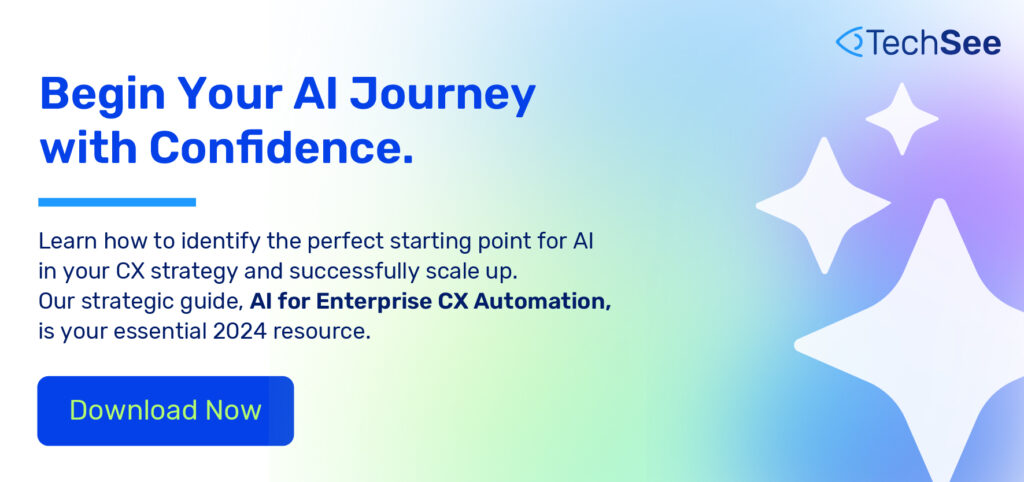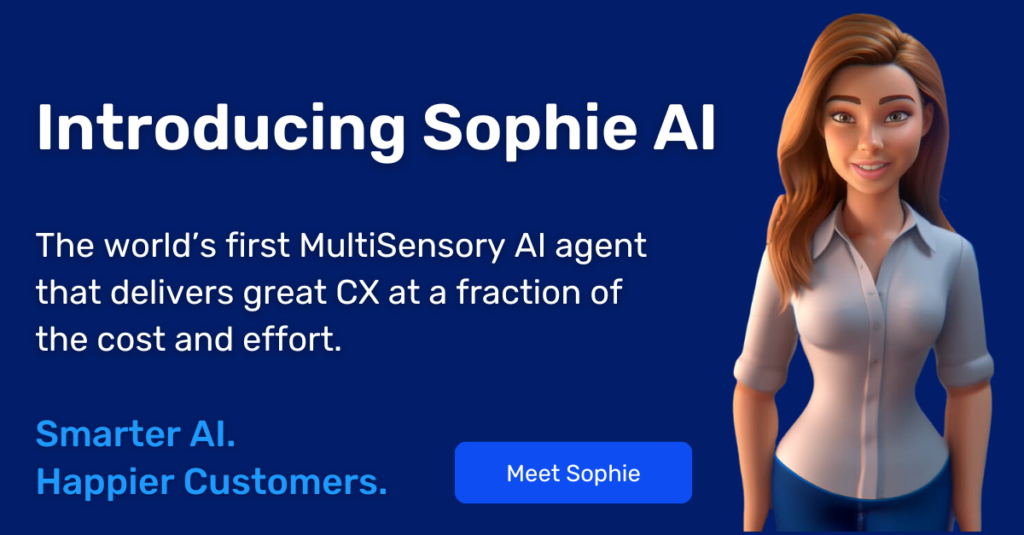Contents
Artificial intelligence (AI) can potentially revolutionize how businesses interact with their customers. However, many enterprise leaders struggle to balance the long-term transformative value of AI with the need to deliver practical first steps that will demonstrate real-world AI in CX success. This post will explore how enterprise leaders can find the optimal first initiative for using AI to augment or automate their customer experience or service.
For the last eight years, the team at TechSee has worked closely with the world’s leading innovators and Fortune 500 brands, deploying real-world CX and bottom-line impact with next-gen AI solutions. Below are some practical best practices when planning and executing a multi-phased AI rollout approach. Remember, AI in CX success is measured not by the complexity or innovation of the AI technology you deploy but the practical value of that AI for your customers and business.
Phase 0: Finding the Ideal First CX Use Case and Team for AI
Before starting the phased deployment of AI, enterprise leaders should identify the ideal first use case or team for initial AI projects. Early insights and success will help them drive continued investment and ensure that they are deploying AI most effectively. Here are some best practices for finding the ideal first use case or team for initial AI trials:
- Identify the business processes that can and should be automated or augmented with AI
It’s critical to start by identifying the suitability, impact, and value of AI automation or augmentations. Enterprise leaders should start by identifying the business processes that (A) can be automated or augmented with AI, and (b) will have a measurable and (c) meaningful impact if meaningfully automated or augmented. This will help them to determine the best use cases for AI and prioritize their deployment. - Start with a small team
Large teams can quickly become unwieldy, especially when approaching a new and different technology. Leaders should start with a small team to test the technology in a controlled environment and identify any issues before it is deployed more widely internally or to customers. This will help them to ensure that the AI system is effective and efficient before it is deployed on a larger scale. - Focus on high-impact potential use cases
Enterprise leaders should focus on the areas where AI can have the most significant impact in the long term and a meaningful impact in the short term. Long-term promise will ensure further investment, but only when you can first show initial short-term performance to justify the further investment. This will help them to ensure that they are deploying AI in the most effective way possible. - Involve employees in the process
Employee input is a critical data source when identifying the ideal first use case or team for the initial AI rollout. Employee input at both the mid-level manager and front-line level will help you ensure that the AI solutions are practical, effective, and efficient for the employees asked to use it.
According to a recent CapGemini report, almost 60% of organizations are integrating generative AI into their marketing efforts, out of which 37% are actively implementing it across various initiatives, while an additional 21% are in the experimental phase. The early investment in marketing automation is now expanding to CX automation. As AI becomes increasingly critical to the enterprise, leaders who do not adopt AI may struggle to catch up to their competitors.
Phase 1: Internal or Limited Rollout, Prove AI in CX Success
The first phase of many multi-phased AI deployments is an internal rollout. This internal rollout allows enterprise leaders to validate the technology and the use-case fit in a controlled environment. This is not absolutely necessary, and some forward-facing organizations are electing to begin with simpler, customer-facing AI experiences in a similarly phased rollout. The advantage for those deploying internally first is that critical issues or shortcomings can be identified and addressed before deployment to customers. However, these challenges can also be overcome with a carefully considered customer-facing limited rollout.
Regardless of the audience engaged in the first phase, leaders must use this phase to identify which business processes can best be automated or augmented with AI in the next phases of the rollout and prioritize further improvements and deployments.
Phase 2: Improvement and Use Case Expansion
As initial rollout results and learnings percolate, leaders’ focus shifts from initial go-live to incremental improvement and expansion. This includes identifying the areas where AI can have the greatest impact and is most suitable based on the insights from the first rollout and then focusing on those areas. Leadership should also focus on improving the accuracy and effectiveness of the AI solutions for the desired use cases and expansion during this phase.
According to a study by McKinsey, AI could end up automating as much as 70% of business processes over the next decade. This transition will not happen overnight, highlighting the importance of deploying AI strategically and effectively.

Phase 3: Learning and AI Userbase Expansion
The third phase of most multi-phased AI deployments is the rapid iteration, learning, and expansion. During this phase, enterprise leaders should focus on rapid iteration to expand and suit new use cases and new audiences. Expansion should naturally build on proven use cases that require minimal refinement. Speaking of learning, leaders expanding AI rollouts should formalize employee onboarding and training for AI to ensure effective usage as the AI scales.
According to a study cited by MIT, upskilling employees with AI can improve their productivity by as much as 40%. However, when AI is used outside the intended task, performance drops by 19%. This highlights the importance of investing in employee training when deploying AI.
Phase 4: Scaling Out AI in CX Augmentation and Automation
Now that you have proven and refined your AI in CX success, you are ready for a wider rollout. Once again, a strategically phased approach will ensure the right first steps and a gradual wider rollout. Remember, when adapting an AI from an internal audience to a customer-facing experience, there needs to be a renewed focus on providing a seamless experience for customers that is easy to use, understand, transparent, and effective. Similar to the initial rollout, you will want to focus first on the use cases where the AI has shown the greatest value and reliability and gradually expand to additional services as they gain a similar level of CX suitability.
Conclusion
Deploying AI to augment or automate your customer experience or service can be complex. However, many organizations have begun activating a phased deployment approach that ensures quality, efficacy, and ROI positivity while enabling the organization to establish the safety, best practices, training protocols, and experience necessary to deliver customer-facing experiences.
To learn more about TechSee’s Sophie AI and how we can help automate and improve your customer experience, please contact us today.







